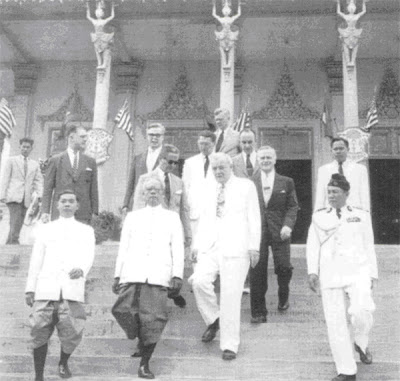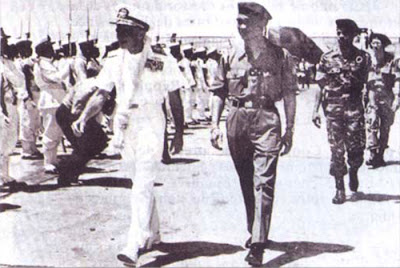1950: State Department recognizes Cambodia
1950: First U.S.
1953: Cambodia
1955: U.S.
1958: Eisenhower and Sihanouk visit to the United States
The US Legation opened in Phnom Penh
Operations were initially conducted from the renowned Hotel Le Royal.
Though the United States had established consular offices in neighboring Vietnam in the late 1800s, there was no official U.S.presence in Phnom Penh United States and Cambodia in the 19th and early 20th centuries was limited to that of missionaries, adventurers, big-game hunters and scientists, with some accounts-like Frank Vincent Jr.'s book, The Land of the White Elephant, which chronicles his journey from Bangkok Cambodia had been a part since 1887), the United States
The post-World War II era saw a distinct shift in relations between the two countries, with Mao Zedong's rmies nearing victory in China and the nationalist, anti-colonialist Viet Minh forces gaining against the French in northern Vietnam U.S. foreign policy increasingly focused on preventing the spread of Communism in Southeast Asia, friendly ties between the United of Communism in Southeast Asia, friendly ties between the United States and Cambodia
Cambodia, along with Vietnam and Laos United States
King Norodom Sihanouk as its head. By May, President Harry Truman approved $20 million in economic and military aid to Cambodia
The United States established its first direct diplomatic relationship with Cambodia Phnom Penh Cambodia
Secretary of State John Foster Dulles visited the Royal Palace
Simultaneously, the United States entered into a mutual defense assistance agreement with Cambodia , Laos , and Vietnam Nong Kimny , Cambodia 's first minister to the United States , on his first visit to America , expressed Cambodia 's "deep gratitude" for U.S. Cambodia , Don V. Catlett, is most remembered for managing the daunting' task of shipping the animal to Washington
After intense negotiations between King Sihanouk and the French government-with the United States United States actively supported Cambodia
Shortly after the Geneva Accords, Robert McClintock became Ambassador to Cambodia
With the King taking the lead, the now fully independent country of Cambodia
Vietnam and fear that Cambodia 's armed forces were ill equipped to handle a possible communist insurgency, the United States began working with the Cambodian government to expand U.S. Cambodia
Bilateral relations between the two countries received another significant boost with the establishment in 1955 of a $50-million-per-year assistance program, which sought to promote economic and social progress; strengthen indepedence; Improve and expand free public education; increase the quantity and quality of agricultural yields; Improve public health, security, and infrastructure; and modernize the armed forces. The aid program was larger in size and scope than the combined support from all other countries and international organiztions, with the United States
American Ambassador William Trimble, with Cambodian Head of State Prince Norodom Sihanouk, cuts the ribbon at the inauguration ceremonies of the model elementary school at Stung Treng, one of fourteen built in various provinces by American Aid.
Other projects included the construction of health centers, pediatric facilities, and a police academy, along with extensive expansion and improvement of Cambodia Phnom Penh with the newly Cambodia
Meanwhile, changes were taking place on the Cambodian political scene. In March 1955, King Sihanouk abdicated the throne to form the Sangkum political party and stand for election later that year. The Prince, as he was now known, handily won the September election and took the post of Prime Minister.
Meanwhile, changes were taking place on the Cambodian political scene. In March 1955, King Sihanouk abdicated the throne to form the Sangkum political party and stand for election later that year. The Prince, as he was now known, handily won the September election and took the post of Prime Minister.
In October] 956, Ambassador McClintock completed his tour and Carl W. Strom was appointed as the next U.S. Ambassador. He presented his credentials to the Prince on December 7, 1956 and remained in the post until March 1959. One of Ambassador Strom's key positions was to protect Cambodia 's sovereignty in the face of increasing aggression from Thai and Vietnamese forces, with which Cambodia
Though ties were strengthening between the United States and Cambodia China United States Washington , D.C. , New York City , Detroit , Chicago , and Los Angeles Los Angeles International Airport
"We haven't forgotten that the United States of America Cambodia can surmount the immense difficulties that shadow the dawn of its independence, it is due, in large part, to the United States
The Prince's visit caused quite a stir in diplomatic circles, particularly following the Cambodian-themed parties he organized in New York and Washington that included a traditional Khmer dance recital given by Princess Bopha Devi, Prince Chakrapong and dancers from the Royal Cambodian Ballet.
Mr. Richard Daley, Mayor of Chicago, welcomes Prince Norodom Sihanouk. (1958)
The Washington Post and Times-Herald called him "the most fabulous party-giver to date", adding that guests "raved over the decor (a Cambodian garden), the dancers and the glittery costumes."
In Washington Cambodia U.S. commitment to Cambodia
Prince Norodom Sihanouk hosts a dinner to honor U.S.
The visit was a highpoint in bilateral relations during the 1950s, with Ambassador Strom commenting, "I was very happy when I learned that the Prince would travel to better know the U.S. United States
The decade would close on a high note: On April 23, 1959, William C. Trimble presented his credentials to the Prince; he would become one of the most successful early Ambassadors to Cambodia Cambodia
The road, now known as National Road 4, is to this day viewed as a symbol of the friendship between the United States
Prince Norodom Sihanouk , U.S. Secretary of Interior Fred Seaton, and Ambassador Trimble inaugurated the U.S. Phnom Penh
"This is a highway of friendship, built through the cooperative efforts of Americans and Khmers who have worked in a spirit of liberty and fraternity toward the goal of economic independence of this country." - Prince Sihanouk
"This highway, built by joint efforts of Cambodian and the United States of America , is the symbol of the friendship of the peoples of our two countries, and of our mutual desire for a free, independent prosperous Cambodia
Speaking in 1961 and looking back on a decade of cooperation, Ambassador Trimble said, "It was a decade of remarkable achievement. ... In these 10 years, this ancient yet modem nation has been laying the foundations essential for continued progress and prosperity. The Cambodian people are vigorously engaged in strengthening and extending these foundations, in an atmosphere of liberty and security."















